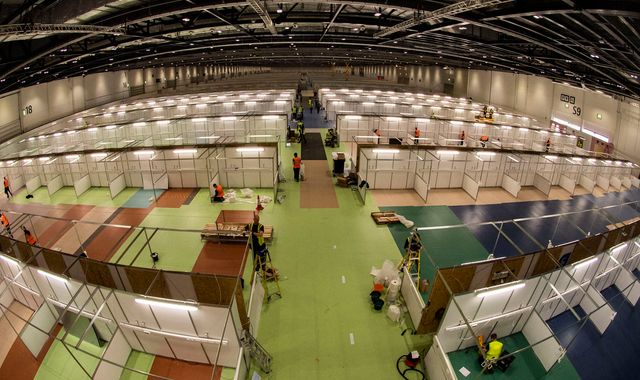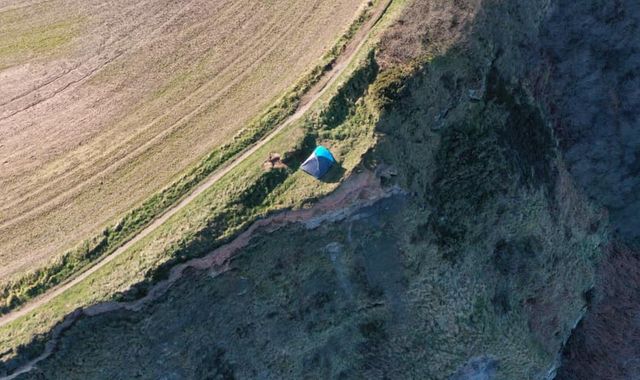Coronavirus: How London’s NHS Nightingale Hospital was built in a fortnight
Written by News on 01/04/2020
From the outside there is not much to suggest that this east London riverside landmark is now the world’s largest critical care facility. The new NHS logo only hints at what is inside.


Two weeks ago the first plans were drawn up to re-purpose this giant conference centre into a specialist COVID-19 field hospital called the NHS Nightingale.
The result is simply staggering.
As you make your way past the shuttered fast food stands, you notice the lines of masking tape on the floor, marking out designated areas. The Costa Coffee stand will be a pharmacy next week.
There is a real buzz inside. Hundreds of people busy making the final preparations as the NHS Nightingale gets ready to take on its first patient.
There are soldiers in full uniform, carpenters measuring and marking, stewards in fluorescent bibs marshalling volunteers through the crowded corridors.
Trucks unload ventilators and other life-saving medical machinery. They will soon be plumbed into a four-mile long oxygen supply network.
Porters hurriedly wheel new beds towards the waiting wards.
Only very sick COVID-19 patients will be brought here for treatment. But they will be patients who are transferred from other hospitals in London and the south.
Emergency cases will still be taken to local hospitals in the first instance.
The movement of patients, staff and resources will be coordinated by response managers in a central command unit in the capital.
Dr Alan McGlennan, medical director for Nightingale Hospital, explained how it would work.
“We’re an NHS facility within London so we take our resources from London,” he said.
“We want to re-coordinate from the centre so they know the best place to deploy staff and resources.
“We are producing a facility that makes best use of that so when we get to capacity and even over, it will be quite clear where to put those resources.
“And at that point we will be ready to receive the equipment, the staff and then the patients, at scale and at pace, at the same standard occurring in the NHS.”
This means patients with other serious underlying health conditions, or those who require specialist treatment that is not COVID-19-related, will not be treated here. It is a single purpose hospital.
This weekend brides-to-be, their excited friends and families expected to make difficult decisions about wedding gowns and decoration at London’s ExCel. But the National Wedding Show has been cancelled.
Instead the difficult decisions might be life and death ones taken by overworked front-line doctors.
A 21st century global pandemic requires an unprecedented response and the NHS Nightingale is just that.
It is a logistical and engineering marvel.
It has gone from a blank sheet to fully operational hospital in less than a fortnight. And that has been made possible because of military expertise.
The language used by the prime minister and his aides is martial. There’s much talk of battle lines being drawn.
So it is appropriate the Ministry of Defence was asked to help deliver this project. Skills honed on the battlefields of Afghanistan have been deployed to the frontline in east London.
It is what Colonel Ashleigh Boreham does best.
“People keep talking about a battle,” he said.
“It’s an unseen enemy. It still is a battle. And it is a timeline that you are working to.
“It’s always trying to get ahead of the picture, of the enemy. And in this case you are trying to get ahead of a virus.
“So the whole idea about building at scale and pace is to build a really fantastic facility that delivers safe care at scale and keeping ahead of the battle, ahead of the virus. That’s what we do.
“The NHS have been absolutely fantastic, we’re here supporting them in delivering an amazing facility, helping them to plan and think things through.”
That expertise is telling. The ward I stood in is more like an aircraft hangar.
There are rows after rows of beds as far as I can see.
This corridor is one-kilometre long. And there are two wards like this.
When it is all up and running there will be capacity for 4,000 patients.
Colonel Boreham said: “We came together about nine days ago, sat around, with social distancing, a coffee table and looked at the designs of this facility and building
:: Listen to the Daily podcast on Apple Podcasts, Google Podcasts, Spotify, Spreaker
“We looked at how to re-purpose it into a design of a hospital system so it has a patient-flow system.
“You literally design on a piece of paper what it looks like with the engineers and the NHS.
“You then present that and you’ve got a plan. Once you’ve got that and a timeline you can start to finesse it.
“We can do that around the world and do the same thing here, literally bent over a table working it out. That’s your start point.”
That was the starting point but now the NHS Nightingale is ready to treat its first COVID-19 patient, less than a fortnight night later. It is the most incredible achievement.
But that is no cause for celebration. It will be though, when she treats her last.
(c) Sky News 2020: Coronavirus: How London’s NHS Nightingale Hospital was built in a fortnight







